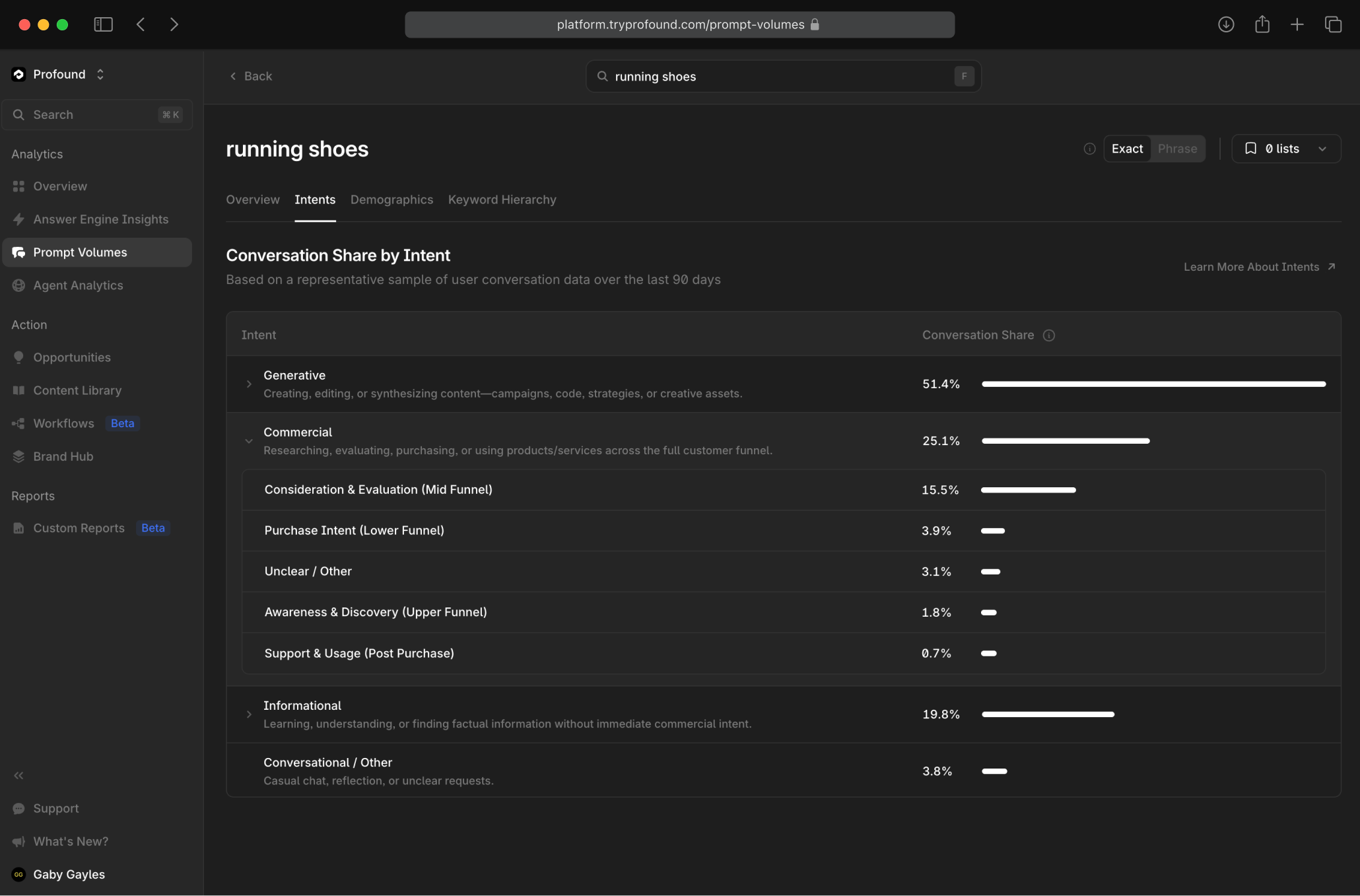We built Prompt Volumes to give brands visibility into what their customers are asking across Answer Engines. It’s become essential for understanding how people use AI when they search for products, explore categories, and evaluate brands.
Now, you can see how different intents drive conversations around any keyword.
Intent Breakdown for Every Keyword
Starting today, Prompt Volumes shows Conversation Share, the percentage of conversations for each intent category, for every keyword you track.
That means you can finally answer:
- How often are people comparing your product to competitors versus simply learning what it does?
- Is your category driving discovery or purchase intent?
- Are users asking AI to create content in your space, signaling generative demand?
- Do support queries dominate your brand mentions, revealing friction points?
Conversation Intent Categories Explained
Every conversation maps to one of four core intents: Commercial, Informational, Generative, and Conversational / Other. Each includes subcategories that reveal exactly what users are trying to accomplish.
Unlike traditional SEO keyword intent, this approach classifies entire conversations rather than individual search queries. It merges commercial and transactional intent into a unified funnel, adds a generative category for content creation, and absorbs navigational intent into subcategories.

Commercial
Researching, evaluating, purchasing, or using products and services across the full customer funnel. Conversations are labeled based on the latest funnel stage the user reached.
- Awareness & Discovery (Upper Funnel) – Exploring needs and generating ideas before focusing on brands.
- Consideration & Evaluation (Mid Funnel) – Comparing or assessing options, specs, or prices.
- Purchase Intent (Lower Funnel) – Ready to buy, book, or subscribe.
- Support & Usage (Post Purchase) – Setup, troubleshooting, or managing owned products.
Informational
Learning, understanding, or finding factual information without purchase intent.
- Definitional & Explanatory – Defines or explains a concept or process.
- How-to Advice – Practical, step-by-step guidance.
- Tutoring or Teaching – Requests for learning help.
- Specific Facts & Data – Seeks concrete information.
- Current Events & News – Recent updates or developments.
Generative
Creating, editing, or synthesizing content—campaigns, code, strategies, or creative assets.
- Writing & Communication (Non-Marketing) – Everyday or professional text creation.
- Marketing & Advertising Content – Promotional or branded copy.
- Plans & Strategies – Outlining plans or frameworks.
- Code & Technical – Writing or fixing scripts or automations.
- Creative, Design, Multimedia – Visual or multimedia creation.
- Problem Solving – Analytical or operational solutions.
- Analysis & Synthesis – Summarizing or diagnosing insights.
Conversational / Other
Casual chat, reflection, or unclear requests.
Why it matters
Intent distribution reveals what customers are actually trying to do, whether they're researching, comparing, learning, or asking AI to create something for them.
Build evaluation guides for comparison queries. Create educational content for informational demand. Develop templates for generative requests.
Stop guessing which content to create. Start matching what people need.
What’s Next
Conversation Intent is just the beginning. We’re building ways to:
- See the top conversations for each intent category
- Add custom tagging so you can define intent categories specific to your business
Get Started
Conversation Intent isn't just another data point; it's the foundation for building content that matches how people actually use AI.
Conversation Intent is available today in Prompt Volumes. We can't wait to see how you use intent data to fuel your AI strategy.
Want to see Prompt Volumes in action? Reach out to our team for a demo.
